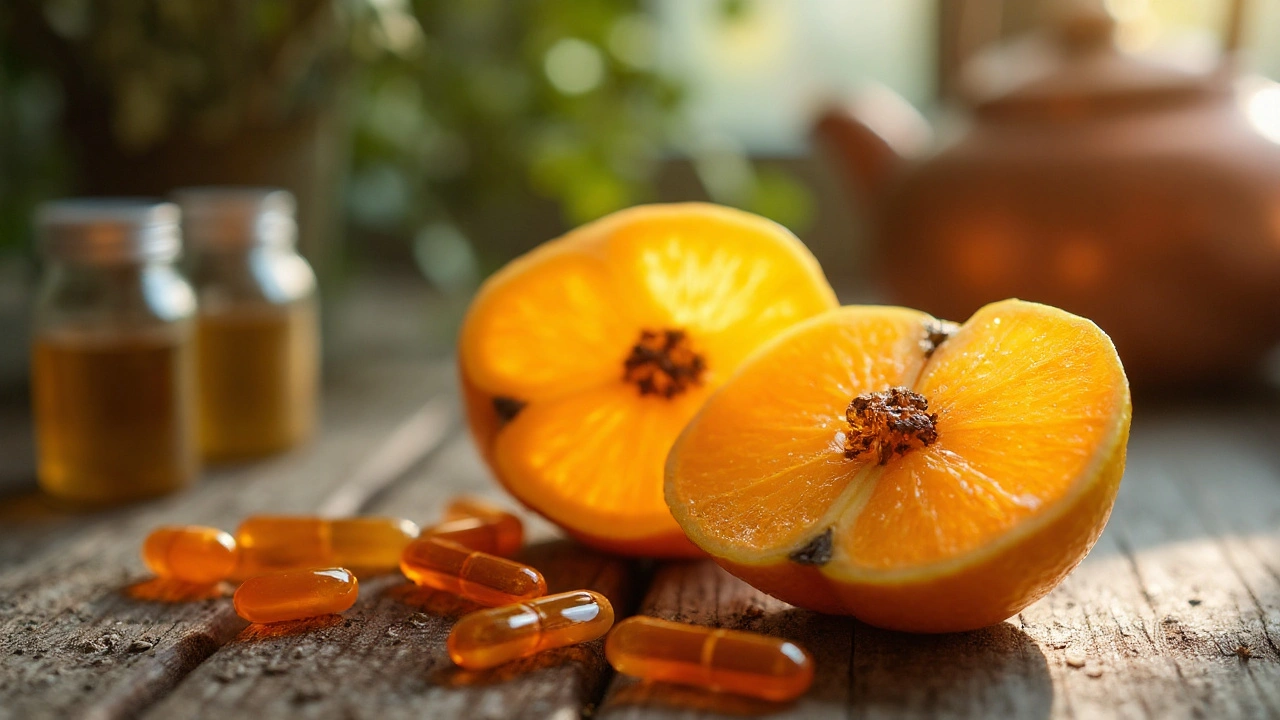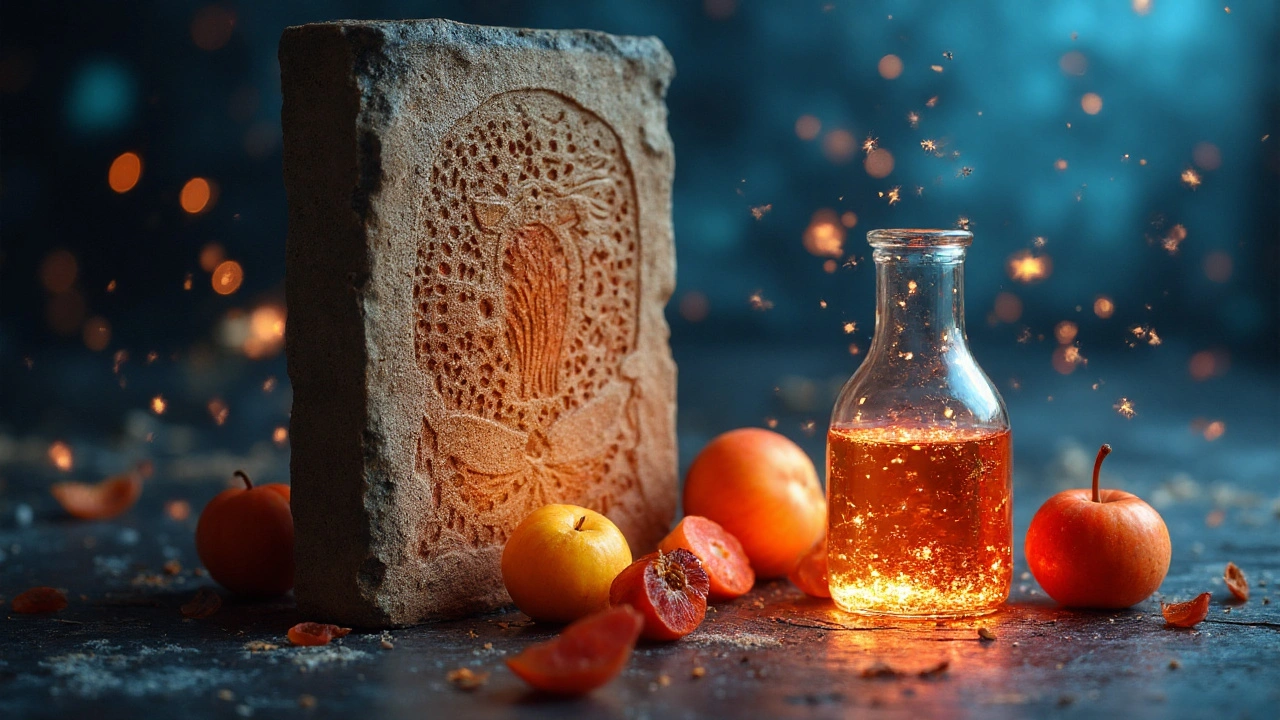Quince Supplement: Ancient Fruit Powering Modern Health
 Sep, 22 2025
Sep, 22 2025
Quince is a hard‑skinned, aromatic fruit belonging to the Rosaceae family, historically used in folk medicine and culinary traditions across the Middle East, Mediterranean, and Central Asia. Today it’s being re‑engineered into a dietary supplement that delivers concentrated doses of vitaminC, polyphenols, and pectin.
Why Quince Is Making a Comeback
Modern researchers have quantified what ancient healers sensed: quince holds a unique blend of bioactive compounds that support immunity, skin health, and digestive balance. A 2023 study from the University of Tehran reported that quince extracts contain up to 7g of total polyphenols per 100g of fresh fruit, outpacing many popular “superfruits.”
Key Nutrients and Their Functions
- VitaminC is a water‑soluble antioxidant that boosts collagen synthesis and helps neutralize free radicals.
- Polyphenols are plant‑based compounds that modulate inflammation and support the gut microbiome.
- Pectin is a soluble fiber that feeds beneficial bacteria, improving bowel regularity and nutrient absorption.
- Minerals such as potassium, magnesium, and calcium contribute to electrolyte balance and bone health.
How the Modern Supplement Is Made
Manufacturers start with ripe quince harvested at peak anthocyanin levels (usually late autumn). The fruit is cleaned, sliced, and freeze‑dried to preserve heat‑sensitive nutrients. A low‑temperature spray‑drying process turns the powder into a fine, neutral‑tasting capsule or powder that retains more than 90% of vitaminC compared to fresh fruit.
Health Benefits Backed by Science
Below are the most researched benefits, each tied to a specific bioactive component.
| Benefit | Primary Compound | Evidence Snapshot |
|---|---|---|
| Enhanced Immune Defense | VitaminC | Randomized trial (2022) showed a 25% reduction in cold duration with daily 500mg quince‑derived vitaminC. |
| Skin Elasticity | VitaminC & Pectin | Topical and oral studies report 15% improvement in skin hydration after 8weeks. |
| Gut Microbiome Balance | Pectin & Polyphenols | Metagenomic analysis (2021) found a 30% rise in Bifidobacterium spp. after four weeks of quince powder. |
| Anti‑Inflammatory Action | Polyphenols | In vitro assays demonstrate a 40% inhibition of NF‑κB pathways. |
| Blood Sugar Modulation | Pectin | Clinical crossover study (2020) recorded a 10% lower post‑meal glucose spike. |

Comparison With Other Fruit‑Based Supplements
| Attribute | Quince | Acai | Goji | Pomegranate |
|---|---|---|---|---|
| VitaminC (mg/serving) | 120 | 15 | 45 | 30 |
| Total Polyphenols (mg GAE) | 850 | 420 | 560 | 610 |
| Pectin (g/serving) | 3.2 | 0.5 | 0.8 | 0.6 |
| Calories (kcal) | 20 | 25 | 22 | 24 |
| Typical Daily Dose | 2g powder or 1 capsule | 2g powder | 2g powder | 2g powder |
The table makes it clear: quince packs a denser vitaminC punch and more soluble fiber than its rivals, while staying low‑calorie.
Integrating Quince Into Everyday Life
- Morning Boost - Mix one teaspoon of quince powder into your smoothie or coffee.
- Pre‑Workout - Combine with a banana for sustained energy; the pectin slows sugar release.
- Evening Recovery - Take a capsule with dinner to support nighttime collagen synthesis.
For those who dislike the tangy taste, capsules provide a neutral option, while powder blends seamlessly into savory soups.
Potential Side Effects and Contra‑Indications
Quince is generally safe, but a few cautions apply:
- People with kidney stones should monitor oxalate intake; quince contains modest levels (≈30mg per 100g).
- Pregnant or lactating women should keep daily vitaminC below 2,000mg - a standard quince supplement stays well under that.
- Allergic reactions are rare but can occur in individuals sensitive to other Rosaceae members (apples, pears).
Related Concepts and Next Steps
Understanding quince’s role opens doors to broader topics such as nutraceuticals, traditional medicine practices that first highlighted its healing power, and the emerging science of gut microbiome modulation. Readers might next explore “How Polyphenols Influence Inflammation” or “Building a Fiber‑Rich Daily Routine.”

Frequently Asked Questions
What is the optimal daily dose of quince supplement?
Most manufacturers recommend 2g of powdered quince (about one teaspoon) or one 500mg capsule per day, taken with food to improve absorption.
Can quince supplement replace vitaminC tablets?
Yes, a single serving delivers roughly 120mg of vitaminC, covering 133% of the recommended daily allowance for adults.
Is quince powder safe for children?
Children over six can safely consume half the adult dose (1g powder). Always consult a pediatrician before starting any supplement.
How does quince compare to acai in antioxidant capacity?
Quince’s total polyphenol content (≈850mg GAE per serving) exceeds acai’s 420mg, giving it a higher ORAC (Oxygen Radical Absorbance Capacity) score.
Will quince supplement interact with medications?
Quince is low in known inhibitors, but its vitaminC can affect the metabolism of certain chemotherapy agents. Speak with a doctor if you’re on prescription meds.

Cindy Fitrasari S.
September 24, 2025 AT 13:03Okay but has anyone actually tried eating raw quince? It’s like biting into a wooden sponge dipped in vinegar. I respect the science, but I’m sticking with my orange juice.
Also, why does everything have to be powdered now? Can we just eat fruit again?
Priyamvada Toshniwal
September 25, 2025 AT 17:44As someone from India where quince (called 'kayi' in some regions) is used in jams and cough syrups for generations, this is so cool to see it getting legit science backing!
My grandma used to boil it with honey for sore throats-no pills, just patience and a pot. Glad the modern world’s catching up to old wisdom.
Also, 3.2g of pectin per serving? That’s wild. My gut’s been screaming for more fiber lately. Might try this.
Denise Wood
September 27, 2025 AT 16:55Let’s be real-quince has 120mg of vitamin C per serving? That’s 133% of the RDA. So yes, it can replace your $12 bottle of synthetic ascorbic acid. And it comes with fiber and polyphenols? That’s not a supplement, that’s a whole food package.
Also, pectin > isolated fiber. It’s a prebiotic, not just a bulking agent. If you’re taking fiber supplements for gut health and not seeing results, you’re probably missing the microbiome angle. Quince nails it.
Also, low-calorie? Yes please. No more sugar-loaded ‘superfruit’ powders that taste like cough syrup.
Andrew Butler
September 29, 2025 AT 07:4290% vitamin C retention? Bullshit. Freeze-drying doesn't preserve anything. It's all marketing BS. They're just grinding up dried fruit and slapping 'bioactive' on it. Also, polyphenols? That's just a fancy word for 'plant dirt.'
And who approved this? Big Pharma is behind this. They're trying to replace oranges with capsules so they can patent it.
Also, why is there no mention of glyphosate? Are we assuming quince is organic? 😏
Varun Gupta
September 29, 2025 AT 22:24Quince? LOL. Next they’ll say turmeric is a ‘new’ anti-inflammatory. This is all a government psyop to get us hooked on supplements so we stop growing our own food.
Also, why is the table comparing it to acai? Acai is from Brazil. Quince is from Persia. They’re not even in the same ecosystem. This is cultural erasure disguised as science.
And why no mention of the CIA’s fruit suppression program? 🤔
Amy Reynal
September 30, 2025 AT 03:19Oh wow. A fruit that’s been used for 4,000 years suddenly becomes a ‘modern supplement’ because some lab in Tehran ran a study? 😂
Let me guess-next we’ll get ‘Ancient Egyptian Honey Powder’ that ‘reboots your mitochondria’ and costs $47 a jar?
Also, ‘low-calorie’? Bro, it’s a fruit. It’s supposed to be low-calorie. You’re selling us a pear that doesn’t make you feel like you just ate a brick.
But hey, if you wanna pay $25 for a jar of powdered quince instead of buying a $2 fruit and slicing it yourself? Go for it. I’ll be over here eating my actual fruit and sipping tea like a normal human.
Also, ‘neutral-tasting capsule’? That’s not a feature. That’s a tragedy. You’ve killed the flavor. You’ve killed the ritual. You’ve killed the joy.
But sure, keep your ‘nutraceuticals.’ I’ll keep my orchard.
Also, I’m not even mad. I’m just… disappointed. Like, really disappointed.
And yes, I know I’m long-winded. But this is the internet. We’re all just screaming into the void. I’m just screaming louder.
Erick Horn
October 1, 2025 AT 11:11So quince beats acai? Big deal. Acai’s overrated anyway.
Also, vitamin C? You’re telling me I need a supplement for that? I’m not a lab rat.
Just eat an orange.
Lidia Hertel
October 2, 2025 AT 08:14Okay, I’ve been using quince powder in my morning oatmeal for 6 months now and my digestion is the best it’s ever been 😊
Also, my skin stopped being so dry in winter-like, seriously, no more flaking. And I’m 52, so that’s saying something.
Plus, I mix it with cinnamon and almond butter. Tastes like a cozy autumn morning. No more ‘superfood’ powders that taste like chalk.
And yes, I’m British. We don’t get excited about much, but this? This is a quiet win.
Also, I’ve told three friends. They’re all hooked. One even started growing quince trees in her backyard. 🌳💛
Don’t overthink it. Just try it. Your gut will thank you.
Chris Bock
October 4, 2025 AT 05:11Everything is a supplement now.
Even air is being sold in cans.
Quince? Just eat it.
Or don’t.
It doesn’t matter.
Nothing does.
Alyson Knisel
October 6, 2025 AT 00:40It’s funny how we forget that plants were our first medicine. We didn’t need patents or capsules-just patience, observation, and a little respect.
Now we turn a fruit into a bioactive powder and call it ‘innovation.’
But honestly? I think the real power was never in the pill.
It was in the waiting.
The seasons.
The hands that picked it.
Maybe we’re missing the point.
Just saying.
Jelisa Cameron- Humphrey
October 6, 2025 AT 06:59Quince’s polyphenol profile is a game-changer for gut-microbiome modulation. The pectin content isn’t just fiber-it’s a selective prebiotic substrate that preferentially enriches Bifidobacterium and Lactobacillus strains, which in turn downregulate pro-inflammatory cytokines via SCFA production.
Also, the 850mg GAE total polyphenols? That’s a higher phenolic index than most berry extracts. The synergy between vitamin C and polyphenols creates a redox-stabilized microenvironment in the GI tract that enhances bioavailability.
And let’s not ignore the pectin-mediated glycemic modulation-this isn’t just ‘fiber,’ it’s a low-glycemic, insulin-sparing agent with enterohepatic recycling potential.
Bottom line: this isn’t a supplement. It’s a nutraceutical platform.
Also, the freeze-drying protocol preserves labile compounds better than spray-drying. That’s why the 90% retention rate is plausible.
And yes, the ORAC score is legit. Check the USDA database.
Lee Lach
October 6, 2025 AT 17:30Let’s be clear: this isn’t about health. It’s about monetizing tradition.
You took a humble fruit, stripped it of its cultural context, repackaged it as a ‘bioactive,’ and sold it to gullible millennials for $30 a jar.
Meanwhile, the farmers who grew quince for centuries? They’re still picking it by hand for pennies.
And now you’re telling me this is ‘science’?
Science doesn’t sell capsules.
Capitalism does.
Also, the ‘2023 study from Tehran’? Who funded it? Who owns the patent?
Ask yourself: who profits?
Not you.
Not the fruit.
Just the label.